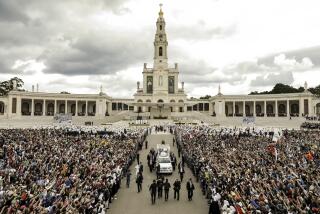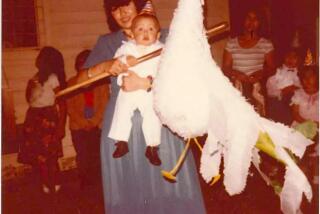Mary Revisited
- Share via
Millions of people say she is the most influential woman who ever lived. Now, two millenniums after her death, they want to know everything about her. Mary of Galilee, the mother of Jesus, is in the midst of a make-over as Scripture scholars, historians, artists and movie makers update her image for the 21st century.
This time, the heated debates about her title as virgin mother and the accuracy of her story as told in the Gospels hardly get mentioned. The curiosity about her is far more basic. Her newest board of examiners wants to know what she did all day, and what it was like to be the mother of Jesus. Some of their most powerful new impressions of her come from comparisons of her problems with those of the underprivileged today.
“There has been a big change in our idea about Mary,” said Eunice Kennedy Shriver, who co-produced “Mary Mother of Jesus” with her son Bobby Shriver. The TV movie airs Nov. 14 on NBC with Pernilla August as Mary and Christian Bale as Jesus. “This happens with political leaders too. Generations later, we see them differently,” she said.
The movie follows the biblical account of Mary’s life, but some scenes are imagined--she teaches Jesus about his Jewish faith, for example. And she doesn’t try to hide her feelings, which rarely surface in the Gospel accounts. Unlike her usual veiled hair, she appears in this movie as the earthy type with long, loose hair.
“In the past, people didn’t dare to construct a story that showed Mary getting angry or anything like that,” said Bobby Shriver. “She’s always been a one-dimensional character.”
That isn’t to say the older images of her are being tossed aside. When mural paintings of the Virgin of Guadalupe were desecrated last month in Los Angeles, the families who placed them on the walls outside their shops launched a loud protest. At about the same time in New York, a portrait of the Virgin Mary with elephant dung attached to her dress spurred New York Mayor Rudolph W. Giuliani to threaten a shutdown of the Brooklyn Museum of Art exhibition that included the painting, by British artist Chris Ofili.
While other divine and saintly figures from Jesus to Moses and St. Paul have undergone highly critical reevaluations in the last decade, the update of Mary didn’t start out as a “tear down.” Instead, she is being respectfully escorted off a pedestal that has kept her from living as full a life as modern historians and Scripture scholars are currently reconstructing for her.
Revisionists Create Mary in Their Image
The complex figure that Mary is emerging to be has some things in common with those who are piecing together her new profile. They live in a cultural melting pot, and she becomes a model for religious diversity. Raised a devout Jew, transformed into an early Christian, honored as the mother of a prophet in the Muslim Koran, she seems as comfortable in an interfaith culture as any contemporary Californian.
Muslim scholars point out that Mary is the woman most often mentioned in the Koran, and they make more of this than scholars did in the past.
“There is some debate in Koranic studies as to whether Mary is a prophet, since God only talks to prophets,” said Zayn Kassam, a professor of religious studies at Pomona College.
Protestants are taking her outside Catholic and Orthodox Christian circles--where she has always been venerated--to create a more prominent place for her in their own, less emotive traditions. At Yale Divinity School, an Episcopal seminary in Connecticut, music and liturgy professor Margot Fassler is teaching a course and writing a book on religious rituals in honor of the virgin.
“Every culture has to find Mary for themselves,” Fassler said. “Today there is the feminist Mary and the right-wing conservative Mary among others. She’s always been our way of figuring out what we need.”
By far the most gripping images of her come from Mexican and other Latin American theologians who see Mary in light of their own countries’ struggles for justice.
“The parallels between Mary and Third World women are almost scary,” said Elizabeth Johnson, a theologian who teaches a course about Mary at Fordham University in New York. “She lived in an occupied country, her son was killed by the state, she was a refugee at one time. They see her as a village woman who had a tough life. Through it all, she kept faith with her calling in novel and dangerous ways. As so many of them do.”
Much of the latest research springs from an urge that Johnson also feels.
“I want to bring her off the pedestal and reweave her into the fabric of men and women’s lives,” she said.
Scripture scholars are asking perhaps the most troubling questions about her. In taking a closer look at details about Mary found in the Gospels, they see challenges to her faith as well as her personal safety. A scene in the Gospel of Luke shows Mary finding her lost child in the temple after three days of searching with her husband, Joseph.
“Why have you treated us like this?” she asks Jesus. Hardly the words of a woman who recognizes that she is speaking to the son of God.
Far more troubling is the suggestion of impropriety in the Gospel of Matthew, in which Jesus and, by extension, Mary, is linked to women of questionable integrity by modern, Western standards. Rehab was known to be a prostitute, Tamar tricked her father-in-law, Ruth seduced a relative and Bathsheba had an affair with David.
Rather than use these texts to cast suspicion on her honor, several scholars have presented them as obstacles that Mary had to overcome as a woman of faith.
“The Gospel accounts connect Mary to scandals about Jesus, and Jesus is always a scandal,” said Beverly Roberts Gaventa, author of “Mary, Glimpses of the Mother of Jesus,” new this month (Fortress Press). “In Luke, the scandal is whether she will eventually understand and follow. In Matthew, there is a threat to her well-being through the mystery of Jesus’ conception.”
L.A. Artist Takes Contemporary Approach
Cutting loose from the frozen portrait of the serene Madonna is leading to other, new interpretations of her, as well. Four years ago, Los Angeles artist J. Michael Walker had an artistic vision of Guadalupe as a modern Mexican peasant that changed the course of his work.
“I could see Guadalupe and the angel who accompanies her releasing themselves from the image and moving about,” he said. “It occurred to me they’d be quite at home in my mother-in-law’s kitchen in Mexico.”
Since then, he has painted a series of pictures showing Guadalupe at home. In one, she presses her cloak with a hot iron. In another, she sits at her kitchen table and reads a letter from her son in the United States who has sent her a money order.
“The idea is to contemporize the image and be highly respectful of the imagery and themes,” Walker said. “This has grown out of my immersion into Mexican rural, lower-class culture where there is a sense of ease in the way people approach the holy powers.”
At first he was not sure whether he would do more than one work.
“It felt bold to tread on new images of Mary,” he said.
A woman friend convinced him to continue. His painting of Guadalupe reading her letter reminded her of the field hands she saw every week sending money orders home to Mexico.
“I realized,” Walker said, “there is the potential for a much more faceted personality of Mary. There is room for many interpretations of who she is supposed to be.”
Even among traditional Christians, the cool, statuesque Madonna is getting more credit as an activist. Janice Connell, a lawyer and arbitrator for the New York Stock Exchange who lives in Washington, D.C., cut back on her practice several years ago to write and lecture about Mary in circles where she once did other business.
Connell has spoken to audiences at the stock exchange, in the Pentagon and at the World Bank about the reverent titles and forgotten prayers to Mary that are the subjects of her books. Her eighth volume, “Queen of Angels” (Tarcher), was published this fall.
The point of her lectures is the same.
“I tell people that Mary is our mother, and she’ll get the best for us,” Connell said. “I pray every day that the whole world will know the love and tenderness she feels for us.”
Books About Jesus Begat Latest Scholarship
The stir of excitement around the blessed mother began as so much else has in her life, with a quest for her son. A flotilla of books about the Jesus of history filled bookstores six years ago. Eventually, that led scholars to look more closely at her. In his case and hers, new information has come from the combined research of archeologists, social historians and Bible scholars.
Recent findings about the times in which she lived raise questions about Mary’s reputation as a poverty-stricken peasant with no social standing.
“We’re realizing that what was important to Mary as a women in 1st century Palestine was family relations and protecting the family’s security,” said Karen Torjesen, a professor of religion at Claremont School of Theology whose field is women’s studies.
“The household was a woman’s domain, and she had great authority there. All the more so because the social structure that Mary lived in was built around the family, not the state.”
The icon of Mary as an empress found most often in Eastern Orthodox art captures something of her prominent place within her family.
“Empress is a strong and powerful image,” Torjesen said.
A.J. Levine, New Testament scholar at Vanderbilt University in Nashville, finds that the quality of life for 1st century women outside the home was not as bad as scholars once assumed either.
“It is usually said that women were no better than pack animals, but that turns out not to be the case,” Levine said. “In the marketplace, in the fields, they worked alongside men and had authority.”
Two Roman cities, Sepphoris and Tiberias, were under construction during Mary’s lifetime. The threat of foreign oppressors closing in on her rural village would have been very disruptive to her family’s security.
“My suspicion is that Mary was very involved with the realities and problems of her world,” Levine said. “I don’t think she was the blond, blue-eyed lady floating on a cloud. Women of her social level in the Galilee didn’t have that option.”
Mary Rourke can be reached by e-mail at [email protected].
More to Read
The biggest entertainment stories
Get our big stories about Hollywood, film, television, music, arts, culture and more right in your inbox as soon as they publish.
You may occasionally receive promotional content from the Los Angeles Times.










